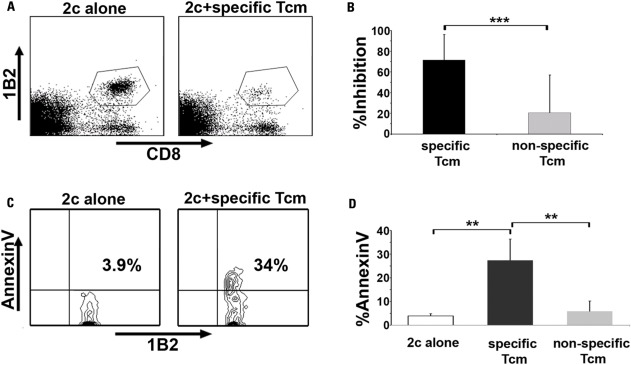FIGURE 2.
Anti-third-party Tcm are endowed with potent in vivo veto activity. (A,B) Lethally irradiated C57BL/6 (H-2b) mice received 1 × 105 CD8+ purified TCR-transgenic 2c cells (carrying TCR with anti H-2d specificity) and 5 × 105 irradiated BALB/c (H-2d) splenocytes. The following day, the mice were transplanted with 1 × 106 C57BL/6-NUDE BM cells or received, in addition, 5 × 106 “specific, ” derived from CB6 (H-2bd, black bars), or “non-specific ” , derived from C57BL/6 (H-2b, gray bars) anti-third-party Tcm. Recipients were sacrificed 8 days post-transplant, their spleens were harvested, and the deletion of anti-donor 2c T cells was monitored by FACS. (A) Representative result demonstrating the level of surviving (7AAD-) 2c cells in the absence (left panel, “2c alone ” ) or presence of “specific ” Tcm (right panel “2c + specific Tcm ” ). (B) Quantification of results demonstrating efficient inhibition of the 2c cells only by “specific ” and not by “non-specific ” “Tcm. ” Data represent average ± SD of percent inhibition from at least 10 animals in each group, pooled from two independent experiments. (C,D) In vivo model was established as in (A,B), but 5 × 105 purified CD8+ 2c cells and 2.5 × 106 irradiated BALB/c splenocytes were administrated. Recipients were sacrificed 8 days post-transplant, their spleens were harvested and FACS analysis of Annexin V levels on living (7AAD-) CD8+1B2+ 2c cells was conducted. (C) Representative result demonstrating apoptosis induction upon anti-donor 2c cells by the Tcm as evident by Annexin V levels on 2c cells in the absence (left panel, “2c alone ” ) or presence of “specific ” Tcm (right panel, “2c + specific Tcm ” ). (D) Quantification of results measuring Annexin V levels on the 2c cells following interactions with “specific ” and “non-specific ” “Tcm. ” The figure shows that Apoptosis was induced only by the “specific ” Tcm. Data present average ± SD of percent Annexin V levels in at least four animals from each group, in one representative experiment, out of three performed. **p < 0.01, ***p < 0.001 (Ophir et al., 2010).

